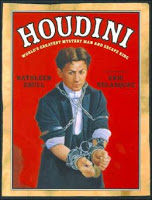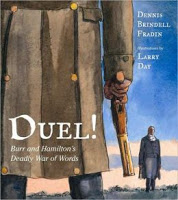Welcome to Part Three of my latest blog thread focused on craft considerations in nonfiction and historical fiction picture books. Basically, this is my private classroom where I peel back the layers and disassemble successful books to learn creative approaches to truth telling. The more I nose my way into the intracacies of these books, the more my pre-conceived notions about “the right way” to pen a marketable picture book biography goes by the wayside. I hope my observations inspired conversations about this genre.
Picture books are most often told with a very simplistic approach; single point of view character; single story line; consistent tense. But, there are exceptions.
Alternating Point of View– A single subject seen through many eyes
LADY LIBERTY: A BIOGRAPHY by Doreen Rappaport. illustrated by Matt Tavares (Candlewick, 2008)
Ten POV characters narrate (in first person pov) this clever biography of the Statue of Liberty, beginning with the author’s introduction. Liberty’s story begins in 1865, France, when Edouard De Laboulaye made the original suggestion of a birthday gift for America. In progressive spreads, we hear from the sculptor, the sculptor’s assistant, the structural engineer (Eiffel,) poet Emma Lazarus, the construction supervisor, newspaperman Joseph Pulitzer, an everyday child, and a journalist. Through these multiple points of view, we watch Liberty evolve from sketch to completion, until she becomes America’s most famous symbol of freedom. Each of those ten points of view are told through first person, present tense. Though the dialog is not lifted from autobiographies, the invented voices are based on solid research.
Excerpt from De Laboulaye’s spread: “I share my dream of a birthday gift. Auguste Bartholdi listens intently when I suggest a monument from our people to theirs to celebrate their one hundred years of independence and ot honor one hundred years of friendship between our two countries.”
Interesting to note:
*Ten first- person point-of-view characters
*Present Tense throughout
*Time span: 1865-1886 (with a final spread reflecting today)
*LOC classification: (not posted in book. LOC site indicates classification as History, Buildings, etc)
*3100 words (per Renlearn.com) 40 pages
*Back Matter: quotes from contemporary immigrants
Statue dimensions
Important Events
Author’s Note – Illustrator’s Note
Selected Sources
TALKIN’ ABOUT BESSIE: THE STORY OF AVIATOR ELIZABETH COLEMAN by Nikki Grimes. Illustrated by E.B. Lewis (Orchard Books, 2002)
This is an older title but worth looking at as a dramatic example of multiple points-of-view. Twenty-two family members and acquaintances ranging from fellow field hands, teachers, laundry clients, reporters, classmates, flight instructors, etc, serve as point-of-view characters in this creative biography about Bessie Coleman. In alternating spreads, and with distinct invented voices, the pov characters speak as if interviewed post-funeral about their recollections of the pioneering aviatrix. And that, following a dramatic opening, which is set during Bessie Coleman’s wake. Yep, the story begins when Bessie’s life ended. I was surprised by this post-funeral setting where Bessie herself briefly serves as pov character. ‘Bessie eyes the gathering of family, friends, and acquaintances from her place in the photo on the mantel behind them.” This unique setting propels the twenty-two person flashback sequence that illuminates Bessie’s life.
Interesting to note:
*22 pov characters speaking in first person
*Present tense opening scene. Past tense throughout remainder
*Time span- Bessie’s death to flashback to childhood-through adulthood (she died at age 34)
*LOC classification: Bessie Coleman-anecdotes-Afro-American women air pilots.
LOC summary : A biography of the woman who became the first licensed Afro-America female pilot.
word count: 5020 (per Renlearn.com) 48 pages
*Back matter: Further biographical info. about Bessie Coleman
*Acknowledgements: author states that voice, style, speech, and characterizations are all imaginary.
*Source Material about Coleman and about Aviation
Alternating Tense Structure– The ying and yang of time: the now and the then
HOUDINI: WORLD’S GREATEST MYSTERY MAN AND ESCAPE KING by Kathleen Krull. Illustrated by Eric Velasquez (Walker, 2005)
From the first page of this p.b. biography, we are drawn into a present tense scene told with a dramatic point-of-view, sometimes called the fly-on-the-wall point-of-view; As if we have walked into a theatre after the show has begun. A narrator is describing the actions on the stage. All the while the tension is mounting as we watch Houdini, handcuffed, lowered into a milk can filled with water. Six padlocks click. “Now, hold your breath! Can you hold it for as long as Houdini? Thirty seconds…One minute…Tick, tick, tick-lungs ready to burst.”
The following pages take us back in time, with a traditional past-tense telling, introducing Houdini as a child, as a young man, as a budding-then famous illusionist. “He was born Erik Weiss in Budapest, Hungary, in 1874(we think).” But, interspersed between the past-tense spreads are additional present tense scenes of Houdini performing his most dangerous feats, told with that “you are there” dramatic point of view.
Interesting to note:
*Six spreads in present tense- Dramatic pov
*Six spreads in past tense-third person pov
*Time span- childhood through adulthood.
*LOC classification: Houdini-Biography
*Word count: 2179 (per Renlearn.com)
*Back Matter: Author’s note titled “Behind the Scenes”
Bibliography
DUEL: BURR AND HAMILTON’S DEADLY WAR OF WORDS by Dennis Brindell Fradin. Illustrated by Larry Day (Walker, 2008)
DUEL! opens with a dramatic scene, told in present tense. “As the sun rises on a July morning in 1804, two men stand ten paces apart on a New Jersey Cliffside. One is Alexander Hamilton, a signer of the Constitution. The other is Aaron Burr, the vice president of the United States. They are risking arrest- and their lives- to fight an illegal pistol duel.” There is an immediate sense of urgency in this “now” telling. It acts as a tease-a hook. But we are swifly taken away from this dangerous scene, back in time far enough to meet the combatants and learn about the events that led to the deadly challenge. “The two enemies had much in common, starting with difficult childhoods.” By page 18-19, we’re back in the present tense again- the day of the duel-the day of Hamilton’s death.
Interesting to note:
*Eight present tense spreads
*Seven past tense spreads
*word count: 1225 (per Renlearn.com)
Back Matter: Bibliography (pg. 32)
The end of dueling
So, there you go. Alternating point-of-view and alternating tense. Both approaches prove that there is no single right way to write a nonfiction or historical fiction picture book.
Next up:
Dramatic point of view- The fly on the wall narrator.
Have you run across other nonfiction or historical fiction picture books with alternating point-of-view, or alternating tense structures? If so, please mention them in the comments section below. Don’t be shy. Let’s start a conversation.






One of my favs is As Good as Anybody: Martin Luther King Jr. and Abraham Joshua Heschel's Amazing March Toward Freedom by Richard Michelson.
One of my favs is As good as Anybody: Martin Luther King Jr. and Abraham Joshua Heschel's Amazing March Toward Freedom by Richard Michelson.
Loved this post, Donna. I've written a picture book biography and been thinking about how to "jazz" it up. This was great information to get me re-thinking the manuscript!
Great post, Donna. I've written a picture book biography and been thinking about how to "jazz" it up. This has me re-thinking the manuscript! BTW QUEEN OF THE TRACK by Heather Lang is one favorite of mine.
Wow, what a grea tpost, Donna. I didn't think anyone liked picking aprt nonficiton as much as I do.
I'm looking forward to future posts as well.
Melissa Stewart
Thank you for chiming in Anonymous and Wendy.
And, Wendy, a special thanks for adding QUEEN OF THE TRACK to the list.
Melissa,
Yep, I'm a picker-aparter of nonfiction. So happy to be in good company. Thanks so much for commenting on my post.
I feel truly heartened by seeing so many great books from 2012!
Me, too, Cathy. There are so many great books making it to the shelves.
Yay!